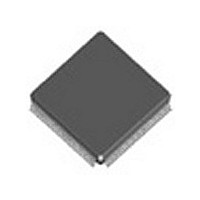ADSP-21266SKSTZ-1B Analog Devices Inc, ADSP-21266SKSTZ-1B Datasheet - Page 3

ADSP-21266SKSTZ-1B
Manufacturer Part Number
ADSP-21266SKSTZ-1B
Description
Manufacturer
Analog Devices Inc
Datasheet
1.ADSP-21266SKSTZ-1B.pdf
(44 pages)
Specifications of ADSP-21266SKSTZ-1B
Device Core Size
32b
Architecture
Super Harvard
Format
Floating Point
Clock Freq (max)
150MHz
Mips
150
Device Input Clock Speed
150MHz
Ram Size
256KB
Program Memory Size
512KB
Operating Supply Voltage (typ)
1.2/3.3V
Operating Supply Voltage (min)
1.14/3.13V
Operating Supply Voltage (max)
1.26/3.47V
Operating Temp Range
0C to 70C
Operating Temperature Classification
Commercial
Mounting
Surface Mount
Pin Count
144
Package Type
LQFP
Lead Free Status / Rohs Status
Compliant
Available stocks
Company
Part Number
Manufacturer
Quantity
Price
Part Number:
ADSP-21266SKSTZ-1B
Manufacturer:
ADI/亚德诺
Quantity:
20 000
GENERAL DESCRIPTION
The ADSP-21261/ADSP-21262/ADSP-21266 SHARC
are members of the SIMD SHARC family of DSPs featuring
Analog Devices, Inc., Super Harvard Architecture. The
ADSP-2126x is source code compatible with the ADSP-21160
and ADSP-21161 DSPs as well as with first generation ADSP-
2106x SHARC processors in SISD (single-instruction, single-
data) mode. Like other SHARC DSPs, the ADSP-2126x are
32-bit/40-bit floating-point processors optimized for high per-
formance audio applications with dual-ported on-chip SRAM,
mask-programmable ROM, multiple internal buses to eliminate
I/O bottlenecks, and an innovative digital application interface.
Table 1
ning at 200 MHz.
product offerings.
Table 1. Processor Benchmarks (at 200 MHz)
1
As shown in the functional block diagram in
the ADSP-2126x uses two computational units to deliver a 5 to
10 times performance increase over previous SHARC proces-
sors on a range of DSP algorithms. Fabricated in a state-of-the-
art, high speed, CMOS process, the ADSP-2126x DSPs achieve
an instruction cycle time of 5 ns at 200 MHz or 6.6 ns at
150 MHz. With its SIMD computational hardware, the
ADSP-2126x can perform 1200 MFLOPS running at 200 MHz,
or 900 MFLOPS running at 150 MHz.
Table 2. ADSP-2126x SHARC Processor Features
1
Feature
RAM
ROM
Audio Decoders
in ROM
DMA Channels
SPORTs
Package
Benchmark Algorithm
1024 Point Complex FFT (Radix 4, with reversal)
FIR Filter (per tap)
IIR Filter (per biquad)
Matrix Multiply (pipelined)
Divide (y/x)
Inverse Square Root
Assumes two files in multichannel SIMD mode.
For information on available audio decoding algorithms, see
[3×3] × [3×1]
[4×4] × [4×1]
1
shows performance benchmarks for the processors run-
Table 2
ADSP-21261
1M bit
3M bit
No
18
4
136-ball BGA
144-lead LQFP
1
1
shows the features of the individual
ADSP-21262 ADSP-21266
2M bit
4M bit
No
22
6
136-ball BGA
144-lead LQFP
Figure 1 on Page
Table 3 on Page
Speed
(at 200 MHz)
61.3 s
3.3 ns
13.3 ns
30 ns
53.3 ns
20 ns
30 ns
2M bit
4M bit
Yes
22
6
136-ball BGA
144-lead LQFP
Rev. F | Page 3 of 44 | July 2009
®
DSPs
1,
4.
The ADSP-2126x continues the SHARC family’s industry-lead-
ing standards of integration for DSPs, combining a high
performance 32-bit DSP core with integrated, on-chip system
features. These features include 2M bit dual-ported SRAM
memory, 4M bit dual-ported ROM, an I/O processor that sup-
ports 22 DMA channels, six serial ports, an SPI interface,
external parallel bus, and digital application interface.
The block diagram of the ADSP-2126x
following architectural features:
FAMILY CORE ARCHITECTURE
The ADSP-2126x is code compatible at the assembly level with
the ADSP-2136x and ADSP-2116x, and with the first generation
ADSP-2106x SHARC DSPs. The ADSP-2126x shares architec-
tural features with the ADSP-2136x and ADSP-2116x SIMD
SHARC family of DSPs, as detailed in the following sections.
SIMD Computational Engine
The ADSP-2126x contain two computational processing ele-
ments that operate as a single-instruction multiple-data (SIMD)
engine. The processing elements are referred to as PEX and PEY
and each contains an ALU, multiplier, shifter, and register file.
PEX is always active, and PEY can be enabled by setting the
PEYEN mode bit in the MODE1 register. When this mode is
enabled, the same instruction is executed in both processing ele-
ADSP-21261/ADSP-21262/ADSP-21266
• Two processing elements, each containing an ALU, multi-
• Data address generators (DAG1, DAG2)
• Program sequencer with instruction cache
• PM and DM buses capable of supporting four 32-bit data
• Three programmable interval timers with PWM genera-
• On-chip dual-ported SRAM (up to 2M bit)
• On-chip dual-ported, mask-programmable ROM
• JTAG test access port
• 8- or 16-bit parallel port that supports interfaces to off-chip
• DMA controller
• Six full-duplex serial ports (four on the ADSP-21261)
• SPI-compatible interface
• Digital application interface that includes two precision
plier, shifter, and data register file
transfers between memory and the core at every core pro-
cessor cycle
tion, PWM capture/pulse width measurement, and
external event counter capabilities
(up to 4M bit)
memory peripherals
clock generators (PCG), an input data port (IDP), six serial
ports, eight serial interfaces, a 20-bit synchronous parallel
input port, 10 interrupts, six flag outputs, six flag inputs,
three programmable timers, and a flexible signal routing
unit (SRU)
on Page 1
illustrates the













